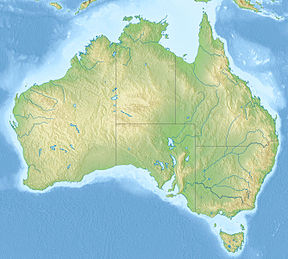- Mungo National Park
-
Mungo National Park IUCN Category II (National Park)Nearest town/city Pooncarie Coordinates 33°44′56″S 143°08′08″E / 33.74889°S 143.13556°E Area 278.47 km² Established 6 April 1979 Managing authorities New South Wales National Parks and Wildlife Service Official site Mungo National Park Mungo National Park is an isolated national park in south-western New South Wales, Australia, 876 km west of Sydney, in the Balranald Shire. It is part of the Willandra Lakes Region, a World Heritage Site covering 2,400 square kilometres, and incorporating seventeen dry lakes. This park is about 75 kilometres south-east of Pooncarie, 110 km north-east of Mildura, Victoria and approximately 145 km south-west of Ivanhoe. The roads to, in or around the park may become impassable during or after rain.
The central feature of Mungo National Park is Lake Mungo, the second largest of the ancient dry lakes. Mungo National Park is most significant for the archeological remains which have been discovered there. The remains of Mungo Man, the oldest human remains discovered in Australia, and Mungo Lady, the oldest known human to have been ritually cremated, were both discovered within the park. They were buried on the shore of Lake Mungo, beneath the 'Walls of China', a series of lunettes on the South eastern edge of the lake.
A visitor centre, is located near the old Mungo woolshed and the entrance to the park, where further information and a map may be acquired. A 70 km signposted circular vehicle track allows visitors to drive to the spectacular Walls of China and around the lakes. The shearers' quarters provide bunk accommodation, and a communal kitchen for a daily fee. Camping and other fees may be paid at the visitor centre.[1]
Mungo National Park was acquired for the National Reserve System in 1979 by the Foundation for National Parks and Wildlife. This organisation fundraised the $101,000 required to purchase the property. The Foundation also funded a resident archaeologist to work on the site from 1979 to 1983. With funds donated by Dick Smith, the Foundation established the Mungo Visitors Centre and Laboratory in 1983. With further sponsorship from BHP, the Foundation implemented the Mungo National Park 60 km long guided vehicle drive in 1990. In 2010 the Foundation is putting together a prospectus to create a new Centre at Mungo for education and research. If this project goes ahead, the Australian architect and winner of the 2002 Pritzker Prize and 2009 AIA Gold Medal Glen Murcutt, along with Wendy Lewin, will design the building.[2]
See also
References
-
Mungo Lunette, looking south towards Mildura, March, 2007
Categories:- IUCN Category II
- National parks of New South Wales
- World Heritage Sites in Australia
- Protected areas established in 1979
- 1979 establishments in Australia
Wikimedia Foundation. 2010.




